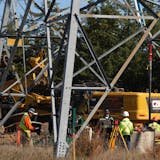One by one, the flour mills that built the "Mill City" a century ago have ground to a halt, leaving one last plant to carry on Minneapolis' industrial legacy of making food from kernels of wheat.
Looming across from the 38th Street light-rail station in south Minneapolis, the century-old Atkinson Mill will soon be the only flour mill left in a city that once boasted dozens of them. The last mill alongside the Mississippi River — which powered the industry's growth — shuttered in 2003, and Archer Daniels Midland (ADM) is closing one of two plants on Hiawatha Avenue.
"It's sad that with that kind of history that you see that disappearing," said Charlie Hatch, Atkinson's plant operations manager. "But it is nice to be still here and still operating and still providing for the community.
The 24-hour operation produces more than 1 million pounds of flour a day, enough to fill 20 tanker trucks. Its floors are packed with rows of grinding and sifting machines, all transforming wheat kernels into flour for bakeries and food production plants. A tangle of pipes transports wheat up, down and across the facility, passing it through textured rollers — some still protected by wooden covers — and giant gyrating sifter boxes that separate flour from its bran shell. It's hot, and visitors are greeted by a pleasant barnlike aroma that's hard to find in the city.
A symbolic tug of war between old and new Minneapolis is playing out just beyond the plant's sparse brick exterior. On one side of Hiawatha Avenue, freight trains arrive with wheat from across the Upper Midwest. On the other, light-rail trains packed with commuters and shoppers have spurred demand to convert crusty industrial buildings into dense housing.
Yet some of those modern urbanites heading to work on the train rely on Atkinson, even if they don't realize it.
"We have a lot of local customers," Hatch said of companies that might turn the flour into bagels, pizza crust or bread. "So I'm sure that a lot of the people sitting across the street probably eat products that originated here."
With 25 to 30 employees, the Atkinson Mill makes seven times as much flour as when it opened in 1915. While Atkinson will soon be the only industrial mill left in the city, Baker's Field Flour and Bakery also produces about 1,000 pounds a day at its three-year-old milling operation in northeast Minneapolis. Most of it is used to make the company's bread.


